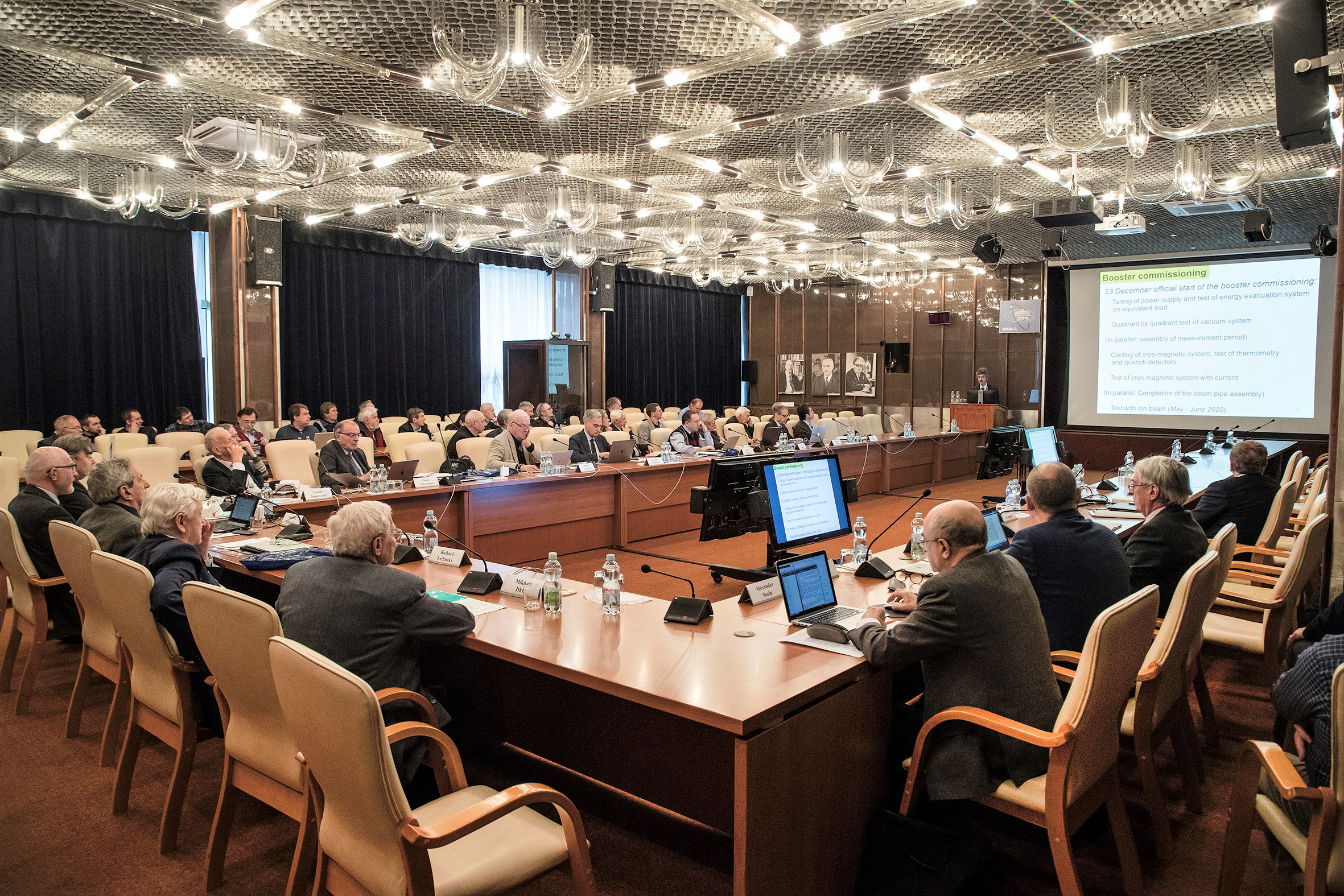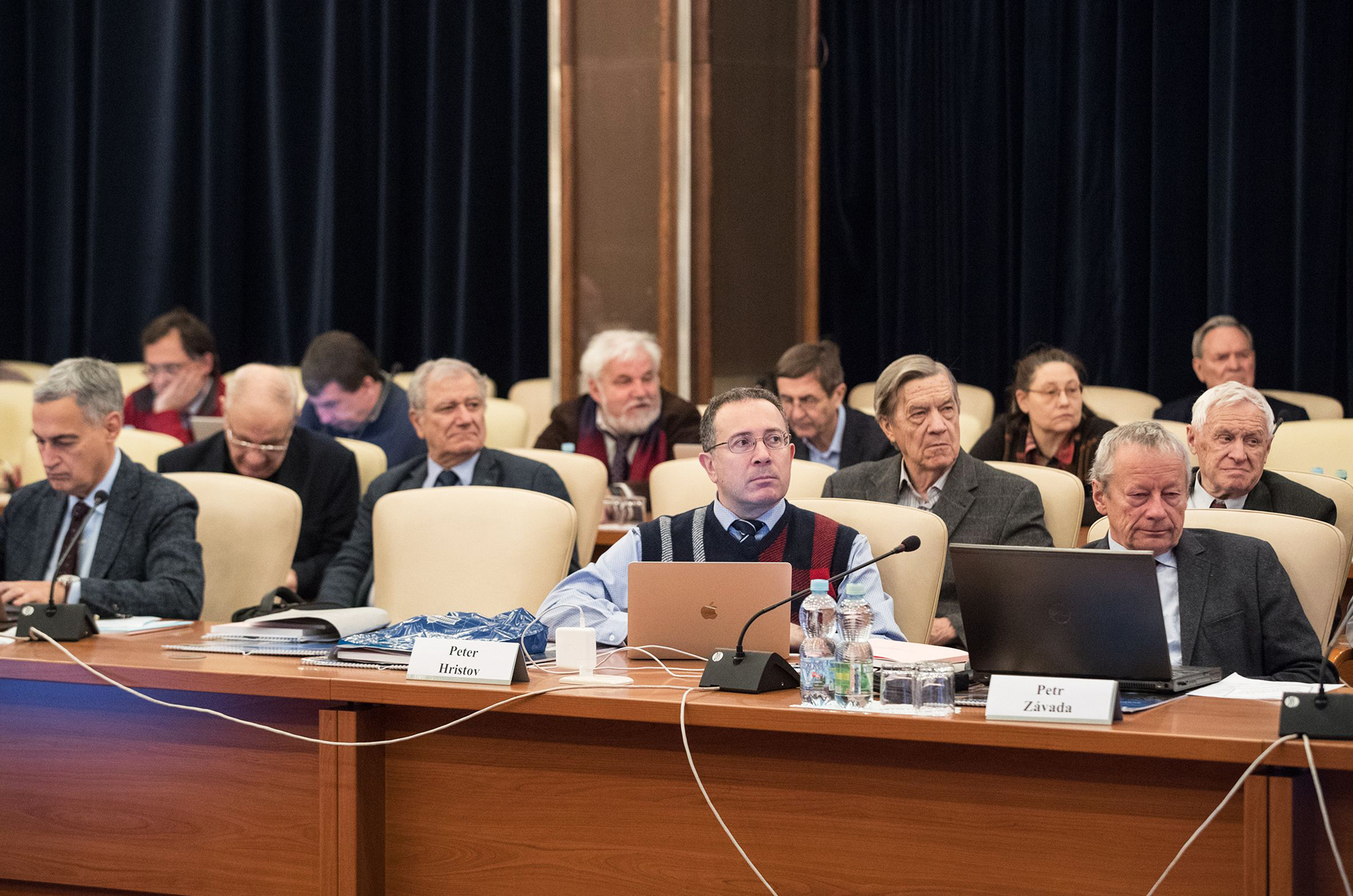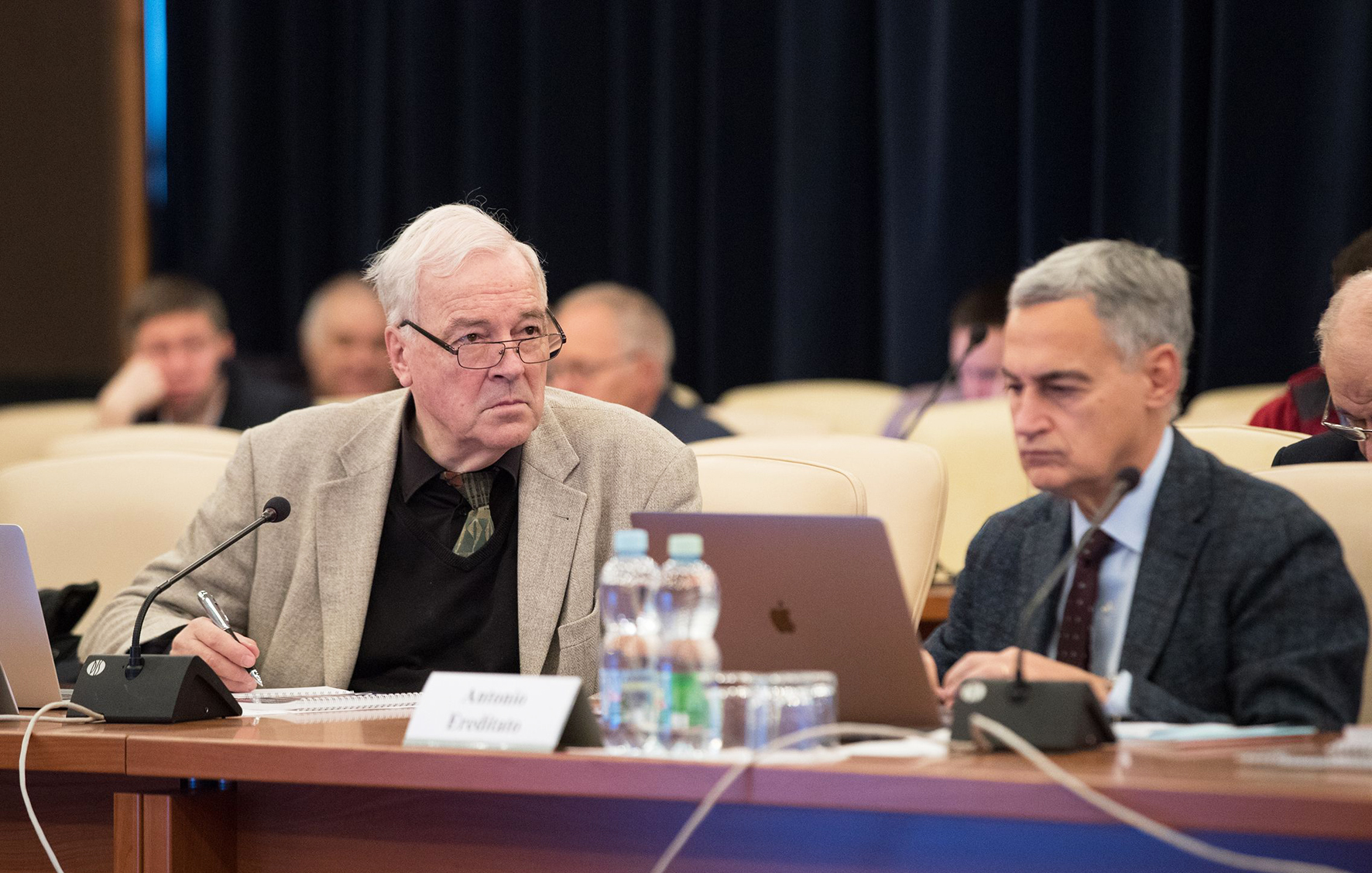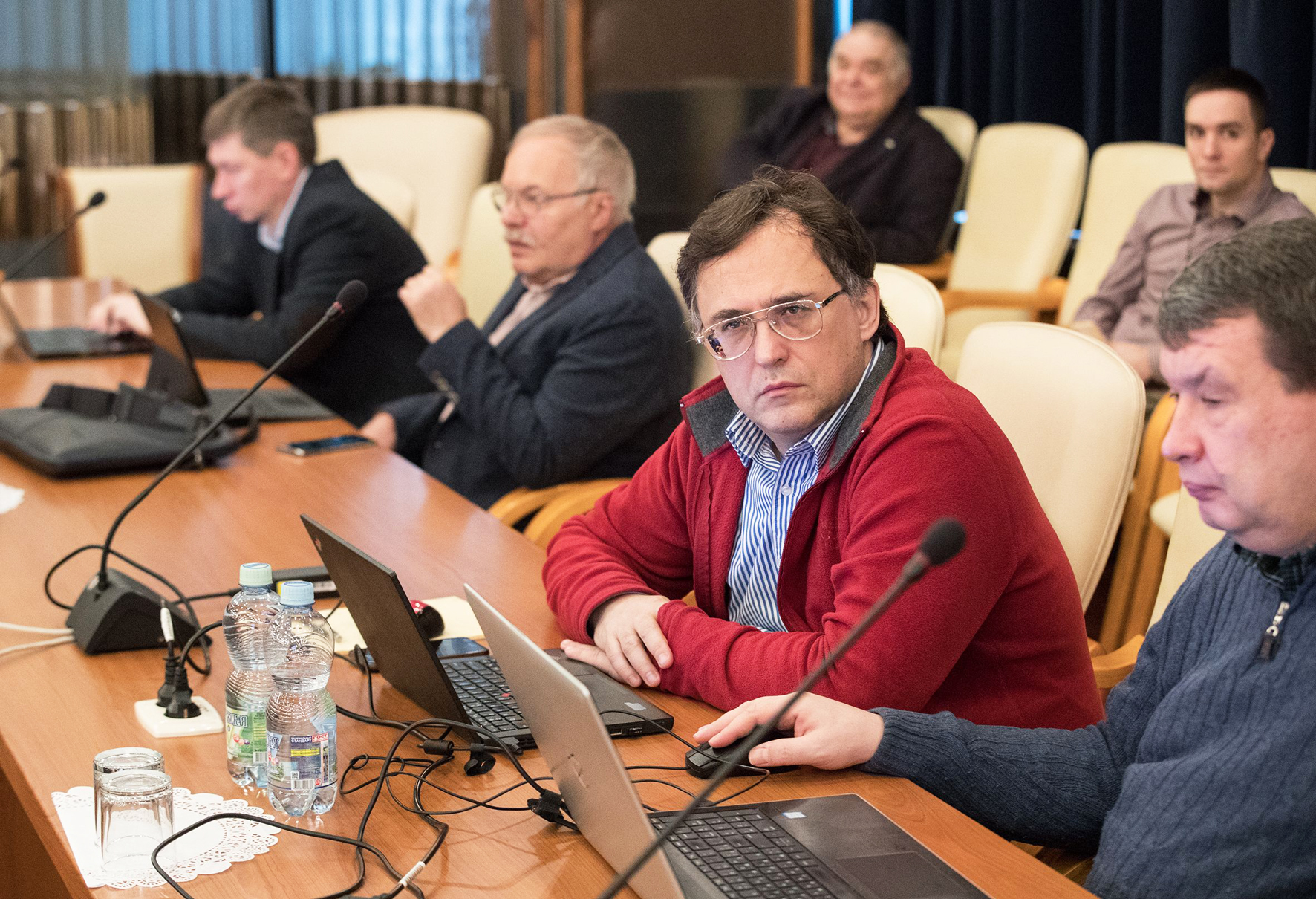NICA and JINR Development Strategy are the main issues
News, 13 February 2020
The 52nd meeting of the Programme Advisory Committee for Particle Physics was held on 3 – 4 February in the International Conference Hall.
The meeting was opened by Chairman of the Programme Advisory Committee Professor I. Tserruya. JINR Vice-Director R. Lednický provided information on the Recommendations of the 126th session of the JINR Scientific Council and decisions of the Committee of Plenipotentiaries of the Governments of the JINR Member States.
The Draft Strategic Plan for the long-term development of JINR in the field of particle physics was presented by JINR Vice-Director Academician B. Yu. Sharkov. Information on the International Working Group for the elaboration of the Strategic Long Range Plan of JINR until 2030 (SLRP), its members, aims and tasks was presented. Moreover, subgroups for particular scientific areas and fields of the Institute’s activities, namely the staff and social policies, administrative work and international contacts, were also discussed. DLNP Deputy Director D. V. Naumov presented the JINR Long-term Strategy in Particle Physics and Astrophysics. The final version of the Strategy is expected to be discussed at the upcoming meetings.
Discussion of the progress towards the realization of the Nuclotron-NICA project started with the report by Deputy Head of the Accelerator Department A. O. Sidorin who spoke about the current status of the “NICA-Nuclotron” project. The PAC members were pleased to note that magnets of the booster were installed at the designed places and the commissioning work started. The Committee supported active preparatory work to start the collider’s assembling, including testing of high-frequency voltage RF-barrier system (RF1) and progress in mass production of the collider’s magnets.
In the interview to the city mass media, A. O. Sidorin noted, “All the systems mentioned today are connected with the Booster. It is the first accelerating element of the NICA complex. Before that, we brought into operation the elements of linear accelerators. It is the first cyclic facility, which is relatively small compared to the collider, but we test our technological solutions at it that will be used in a larger facility. It turned out that the Booster found out problems as well, including those in the work organization and administrative measures, our interaction with various contractors in terms of the production of the accelerator’s elements, the construction of buildings. It is not always possible to select adequate producers, agreements do not always include effective measures to influence contractors and to ensure that they comply with the contract provisions. But at the same time, we have internal problems. We construct the accelerator facility at the most advanced scientific and technological level; there is no relevant experience in the Russian Federation, so it causes some difficulties. There are also internal problems of training the qualified staff. The accelerator part of the NICA project still lacks employees. Nevertheless, we expect to conclude assembling and testing the Booster in the nearest future. It is already possible to bring the beam from the linear accelerator to the Booster. It is difficult to predict when exactly the beam will be available to consumers. Everything depends not only on the accelerator but on the experimental infrastructure, whether consumers are ready for work at our beam or not. In any case, we can confidently name the year 2021 the beginning of the programme of fundamental research. Our plans are being adjusted in accordance with our progress. They are, in fact, correspond to the Federal project “Nauka”.”
The report on the infrastructure developments, including the Nuclotron, presented by VBLHEP Chief Engineer N. N. Agapov was then considered. The PAC members highly evaluated the openness of the report that named the reasons for delays in civil engineering and proposed to revise the procurement procedures.
Spokesman of the MPD collaboration Chief Researcher A. Kisiel presented the report on progress towards the realization of the MPD project. He noted the efforts of the collaboration to develop the elements of the detector and thus to conclude the first stage of its creation and bringing it into operation until the end of 2021. Progress towards the realization of the BM@N project presented by Spokesman of the BM@N collaboration, Head of the Sector M. N. Kapishin was also highly appreciated. Efforts made to conclude the preparation of the experimental facility for work with heavy ions in 2021 were highlighted.
VBLHEP Deputy Director Yu. K. Potrebnikov commented on the work progress with the following words, “2019 allowed us to start the launch of the Booster. We have recently carried out a test launch of power systems of the Booster, brought into operation a new computer cluster. As for detectors, the first physical result in the BM@N experiment is being prepared for publication in the refereed journal on behalf of the BM@N collaboration. The MPD collaboration has been formed that works efficiently, four relevant meetings were held. The infrastructure is developing. The foundations of the cryogenic station building are already constructed although there was a great delay.
Building #17 is being actively constructed (this includes a collider complex with a ring, channels, two pavilions for MPD and SPD), and we are supposed to finish it at the end of the year. Moreover, transportation of the cold part of the solenoid magnet of MPD to Dubna is underway.
NICA Centre. The agreement we have signed with the Russian Federation involves the creation of a centre for NICA users to provide workplaces, relevant equipment, computers, halls for meetings. We have designed such a centre. However, it turned out to be too expensive. Nowadays, the centre was once again designed within the means we have. The new design will be presented to the FAI “Glavgosexpertiza of Russia” in spring, and we hope it will be approved in April. After that, we will run a tender and construct the centre next to the collider’s building. There will be approximately 350 seats, a hall for 250 people that may be transformed into several small halls. There will be also meeting rooms in the format of small rooms for 20-25 people to hold meetings and videoconferences. Furthermore, a round pavilion at the top of the building will be added with a viewpoint and a café. And there will be a computing centre, the main cluster of our computer complex.
In fact, the computing centre of the NICA project is distributed, it will consist of four clusters. One of them, a so-called online-cluster, will collect information from all the facilities and the accelerator unit of the complex. It will collect events and send them for processing to off-line clusters. Moreover, the operation of the complex will be monitored. Three other clusters will be geographically divided. The first of them, in building #216 opened last year, has been already launched. It is almost the same, maybe a bit more powerful in terms of performance than Tier2 in the Laboratory of Information Technologies. It is a good complex, it is ready to operate at full capacity, now the load is only 30-35 per cent. There will be a complex in LIT with similar computing resource, it will be also storage for big volumes of data. Jointly with LIT, we bought a robot for 40 petabytes, 16 of which are allocated for the NICA project. It has been already delivered, and now is being installed. The third cluster will be used in the NICA Centre. It will be approximately two times more powerful than that of building #216. In addition to these four clusters, each detector and the accelerator complex will have its technological computer network.
As for the construction: building #17 is the main one, it is now being constructed. We now formalize the last additional agreement that states that all the construction work will be completed at the end of the year. At the same time we agreed with the general contractor that we will install equipment without waiting for the full completion of the construction, but as soon as the buildings are ready. And the first one is the MPD building. We are promised that it will be ready in March so that to start installing the yoke of the magnet of the multipurpose MPD detector. The cryogenic and compressor station is a significant object that is expected to be completed this year. It is crucially important to build the 15th electrical substation that will supply energy to channels going to the BM@N detector. Without it, it will be impossible to implement a run in the middle of the next year.”
***
Head of the Sector A. P. Cheplakov presented the plans for the modernization of the ATLAS detector. The Committee highly evaluated progress achieved by the JINR team towards fulfilling its obligations in the ATLAS modernization project. It was also noted that the Phase I and Phase II were supported by grants of the Ministry of Science and Higher Education of Russia. The PAC members are concerned that the JINR team is divided into two groups: one working on equipment and another engaged in the analysis. Such a division contributes to the increase in the number of scientists engaged only in the analysis and thus knowing nothing about the detector, and vice versa. The PAC PP repeats its recommendation to consider the possibility to unite these two groups and advises to continue the participation in the project of the ATLAS modernization for the period 2021 – 2023 with the first priority.
Moreover, the PAC members expressed their interest in the revised proposal for the NA64 experiment presented by VBLHEP Scientific Secretary D. V. Peshekhonov. The plan of actions for attracting students to the participation in the data analysis was implemented; the full-time employment (FTE) ratio to the number of participants increased by 60 %, 4 new students were involved in modelling, data analysis, development of electronics and the detector. It was recommended to approve the NA64 project for 2021 – 2023 with the first priority.
The revised proposal for the FASA experiment presented by a VBLHEP leading researcher S. P. Avdeev raised doubts about rationality to use the detector to study the processes of multi-fragmentation. It is recommended to reject the FASA project proposal.
Participants of the PAC meeting expressed their interest in the proposal for opening a new project “Search for new physics in the charged lepton sector” with three experiments – Mu2e and MEG-II presented by V. V. Glagolev and the COMET experiment reported on by Z. Tsamalaidze. The scientific value of research for new physics, the experience of the authors sufficient for carrying out these experiments, as well as the participation of young scientists, were noted. However, the PAC members were dubious about the participation in three various experiments with very similar scientific goals. Therefore, it was offered to focus efforts and resources on one experiment, and in the meantime approved the project with three experiments for one year to respond appropriately.
The PAC members took into account the reports on scientific results obtained by JINR teams in experiments at LHC. E. P. Rogochaya reported on the ALICE experiment. E. V. Khramov presented the report on physical results in the ATLAS experiment. V. Yu. Aleksakhin presented new results and the current activities of the JINR team in the CMS experiment. The participation of teams in the data analysis, development of software, and modernization of facilities received high estimation.
Participants of the meeting heard the scientific report “Pion at various stages of heavy-ion collisions” made by E. E. Kolomeitsev (BLTP). In addition, DLNP, BLTP and VBLHEP young scientists made 18 poster presentations on particle physics at the meeting. The poster “Detection of the neutrino signal of a supernova in real-time mode” presented by a DLNP researcher A. S. Sheshukov was recognized as the best one. It was recommended to present it at the session of the JINR Scientific Council in February 2020.
The next meeting of the PAC for Particle Physics will take place on 29 – 30 June.
Galina Myalkovskaya, JINR Weekly Newspaper
Photos by Igor Lapenko



